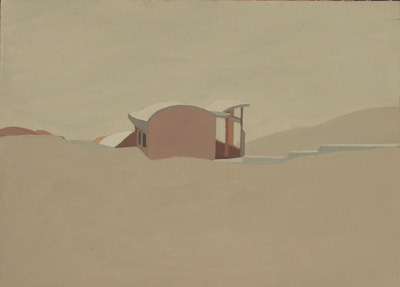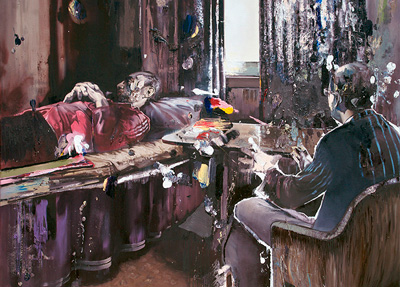Gulliver Trapped in a Bottle
By Suset Sánchez Sánchez
The initial sequence in the film Citizen Kane, a masterpiece by Orson Welles, shows the moment in which the tycoon character dies, while from his lifeless hand a crystal ball falls and shatters into a hundred pieces as it hit the floor. Also known as snow globes and invented in the 19th century, these artifacts are symbols of the modern ideal of world domination, replicating a scaled down model of urban and rural landscapes or monuments. These mass produced tourist souvenirs miniaturize reality and eternalize the image of a place in a continuum loop where it never ceases snowing. Nonetheless, these are articles of consumption, anthropologically and culturally marked by the experience and history of those who acquire them as a gesture of memorabilia.
At first glance, some of Alan Manuel Gonzalez’s hyperrealists canvases seem to have been constructed to trap the neocolonial omnivorous and predatory fascination of the occasional tourist who travels in search of stereotypical and preconceived images of Cuba: the city in ruins, the spontaneity and revelry of the Havana people, and the antique cars from 1950’s that seem to have risen from the ashes, which is perhaps the best example of the persistent resiliency of Cubans. However, this strategy of visual seduction, is nothing more than a false veil for the unwary eye that is not striving to rigorously observe the painting; a trompe l’oeil that pursues as in the fable of the «trapped hunter», those who like tourists in search of a cheap souvenir, long for the easy and superficial photo to post on their social networks, without establishing a minimum commitment towards the desperate reality they left behind when flying back to their homes.
Alan Manuel’s paintings does not deny those clichés that are in part truth. He moves in a complicated balance between the everyday social landscape and a critical discourse where time becomes a metaphor of an existence that pushes through pressing precariousness and difficulties. His paintings are capsules of that extreme and controversial reality, fragments of life confined in transparent containers that allow us to watch but not to get too close. The fragility of glass becomes a symbol of weakness in that ecosystem subjected to the pressure of history, to a long wait in which time has stopped, as if the fine funnel of an hourglass had been obstructed. The island is then the image adrift of a shipwreck, a geography, a country, a nation of people trapped in a bottle. «The damn circumstance of water everywhere» that Virgilio Piñera wrote in his memorable La Isla en Peso. Like it happens with this poem, we can almost hear the anguished and desperate scream coming from Alan Manuel’s pieces that say: «No one can escape, no one can escape!”.
The encapsulated characters sometimes press themselves against the glass to call viewer’s attention, maybe looking for help to escape from their captivity (“Marveled or Self-Portrait at 45th”. 2017). They cannot be heard, though, for their sounds are not able to break through the hermetic wall of that “Deaf Bubble”, like its author has named it. Many times those figures are recurrent self-portraits in continuous attempts to flee, whether by climbing a slender royal palm tree vertically growing until it opens the cap of an empty milk bottle (“The Escape” II, 2018), or by pushing the cork out of a “Test Tube” (2017) to liberate itself from the risky experiment that the Cuban Revolution project has been.
But then, in the artist’s most recent canvases the containers restricting the form that lived inside have disappeared. The liquid metaphor present throughout Alan Manuel’s entire work has broken the barriers that once defined the thousands of glass objects in which life on the street remained trapped. His current project remodel the tension of those fragile structures as the new visual allegories are kept inside ready to burst liquid bubbles. I don’t know if Alan Manuel Gonzalez have read anything by sociologist writer Zygmunt Bauman, but, without doubt, his capacity to observe the social context of the present Cuba and create these imaginary fluids, cannot be more accurate to describe or allow us to perceives the latent transition that is about to take place.
It is often said that reality surpasses fiction. Being confronted with these bizarre scenes where island’s inhabitants carry on with their daily struggles while the water is literally up to their knees, remind us of the dramatic photographs of a country hit by hurricanes and flooding. This wicked combination between time and space and -yet again- the damn circumstance, makes the situations in the island worse by further draining the life out of its people already enduring economic and political crisis for more than half a century. In this sense, it is highly symbolical that bubble in which a shark -it could very well be the symbol of capitalism- uproots the concept of nation embodied by the royal palm tree; or the one in which a hummingbird catches a hundred dollar bill with its beak.
On the tag of every antique car painted in Alan Manuel’s canvases, we can read «1959-2018». The Cuban people have climbed aboard this outdated vessels to slowly get across the stage of national history, crammed into a concept of the collective that is «sinking the boat» in the current historical-social juncture. Knowingly that the bubble in which they have been submerged for so many years is diluting and losing its form bit by bit. Perhaps the message suggested in these paintings with the greatest possible realism -or with uncertainty-, is that the responsibility ultimately falls on its people, inhabitants of a miniature island, an imperfect model that floats inside a crystal ball in the Caribbean Sea, for it is up to them to make the bubble burst. It is also their decision of whether to fall into the abyss of geopolitical hostility or to move with fluidity towards change, without forgetting the good values still engraved in our humanity. In any case, the work of Alan Manuel Gonzalez is an account of that tense wait, of the fragile border that separates the island, as an idealized place in the political imagery of the 20th century, from the surrounding global landscape. Its bubbles and crystal architectures are chronotopes in which the epic national daily life is written in lower case.



